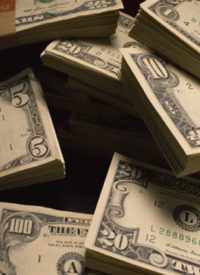
The notes of the latest meeting of the Federal Reserve, released on Tuesday, clearly show the Fed’s next step in trying to solve the problem it has created: Quantitative Easing II, or QE2 (qualitative easing is Fed-speak for increasing the money supply). The meeting lasted more than five hours and consisted of a debate about when to start the process: now, or later.
Some on the board “consider it appropriate to take action soon,” while others said the Fed should act “only if the outlook worsened.” Reporting on the release, the New York Times said this is “one of the hardest choices the Fed has faced since the recession began.”
In a clever sound-byte, Robert D. McTerr, past president of the Federal Reserve Bank of Dallas and a supporter of QE2 now, said, “If you lead the horse to water and it won’t drink, just keep adding water and maybe even spike it. You definitely don’t want to take the water away.”
Of course, by expanding the money supply (which the Times reveals in a remarkably candid explanation here) the effect of QE2 “is the same as printing money in vast quantities.” In that explanation the Times made clear not only McTerr’s lack of understanding about how money works, it reveals ignorance of the result of increasing the supply of money: Its purchasing power is not “spiked” but diluted further.
Some signs of intelligent life did appear at the meeting, however. H. Robert Heller, a former Fed governor, opposed doing any more diluting, distancing himself from the pending disaster: “I would do nothing. If they start to monetize the federal debt, they will dig themselves a much deeper hole later on. That’s what we learned from the 1970s, when the Fed undertook a very expansionary monetary policy. It took a double recession in the early 1980s to wring [that] inflation out of the economy. [Emphasis added.] We don’t want to repeat that.” Also, in a speech in Denver on Tuesday, Thomas M. Hoening, president of the Federal Reserve Bank of Kansas City, said: “If we have learned anything from this crisis, as well as past crises, it is that we must be careful not to repeat the policy patterns we have used in previous recoveries.”
Sheldon Richman, an Austrian-school economist (a free-market economist) and editor of The Freeman, explained the process involved in any inflationary strategies employed by the Fed: “When the federal government spends more than it taxes, it has to get the extra money somewhere…. It borrows from the credit markets by selling Treasury securities to investors.” This isn’t inflationary as there is no new increase in the money supply, merely a shifting of existing credits from one place to another. But, when the Federal Reserve buys Treasury securities, “it pays for those securities by creating bank reserves” — money from nothing — or, as economist John Maynard Keynes suggested, by performing the “miracle … of turning stone[s] into bread.”
Richman makes clear what is happening here:
The additional quantity of money [created from nothing] does not find its way [evenly] into the pockets of all individuals; not every individual of those benefited first gets the same amount and not every individual reacts … in the same way….
[Thus we see] that inflation is a form of government distribution of income….
Make no mistake about it. This is a government-engineered transfer of resources, that is, a violation of property rights. And by the way, the distribution is not from rich to poor. If anything, the distribution is upwards.
At what point, then, does the resulting inflation push the price level up so fast that individuals, rather than conserving (or “hoarding,” a pejorative used by the monetary statists) their cash, perceive it more in their own self-interests to start spending the cash before prices “run away” from them? When, in other words, “Will we have hyperinflation in America?” as explored by Jeffrey Harding.
Harding outlines 12 steps toward a “hyperinflation setup” including:
• Government spending continues unabated;
• Taxes increase;
• The economy slows further;
• The government sells even more debt to the Fed;
• Interest rates on that debt rise significantly;
• The Fed buys more and more of that debt;
• Inflation takes off, showing monthly and then weekly rises in the price level of common items in stores and supermarkets.
To be fair, Harding doesn’t conclude that hyperinflation is imminent. While “a careful analysis of theory, fact, and history leads me to conclude that inflation … is in our future, it is quite of leap of fancy to say we are certain to have hyperinflation.” In fact, as of now, as was just confirmed by Bloomberg News, “Inflation in the U.S. will fall short of the Federal Reserve’s long-term goal [of 2 percent].”
On the other hand, graphs from the Federal itself (here and here) show the early warning signs of the two elements that must be present for hyperinflation to begin: an increase in the supply of money, provided by the Ship of Fools running the Fed, and the velocity of money, reflecting individuals’ rate of spending of that money before it loses any more purchasing power. Both are increasing.



